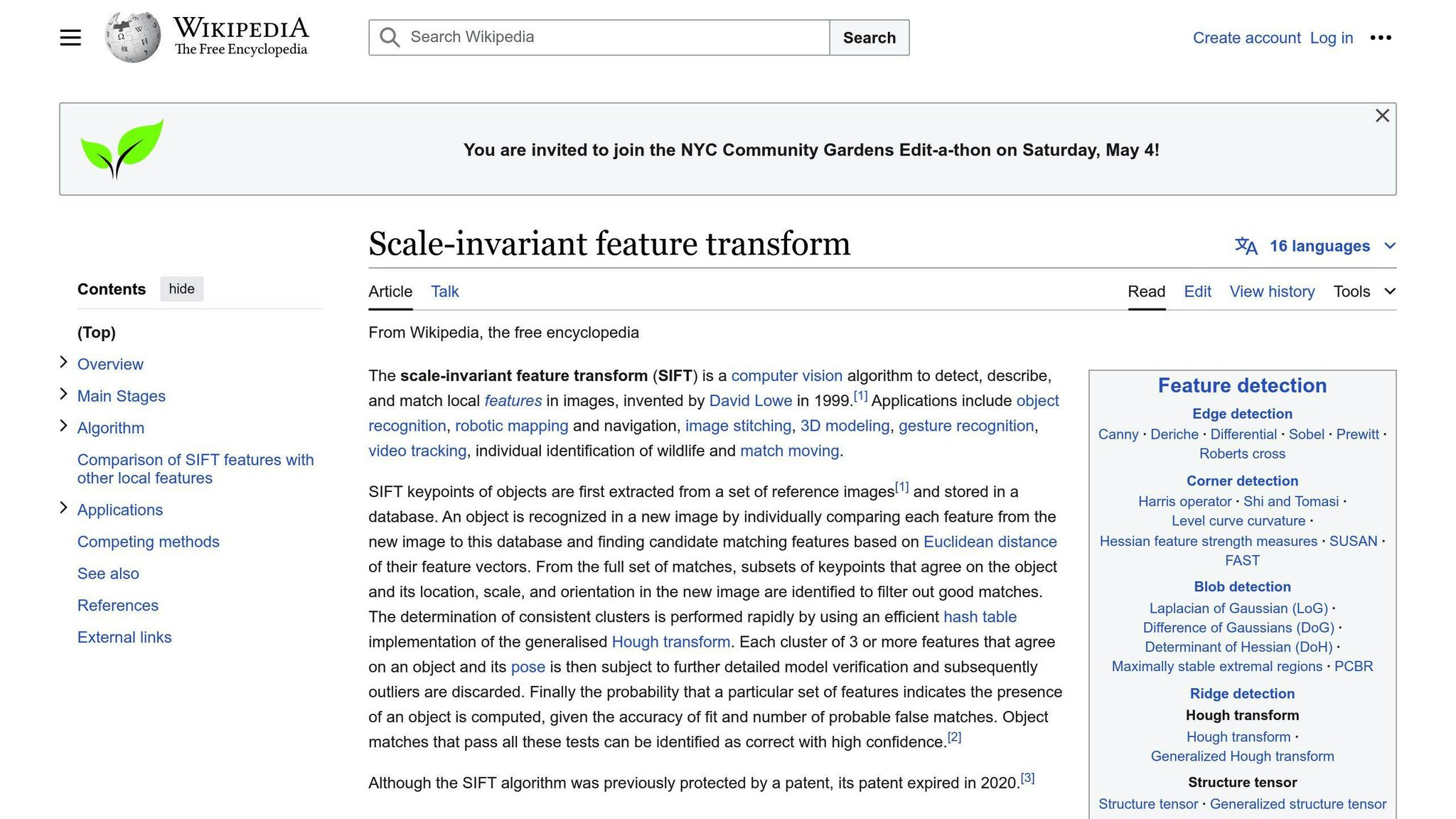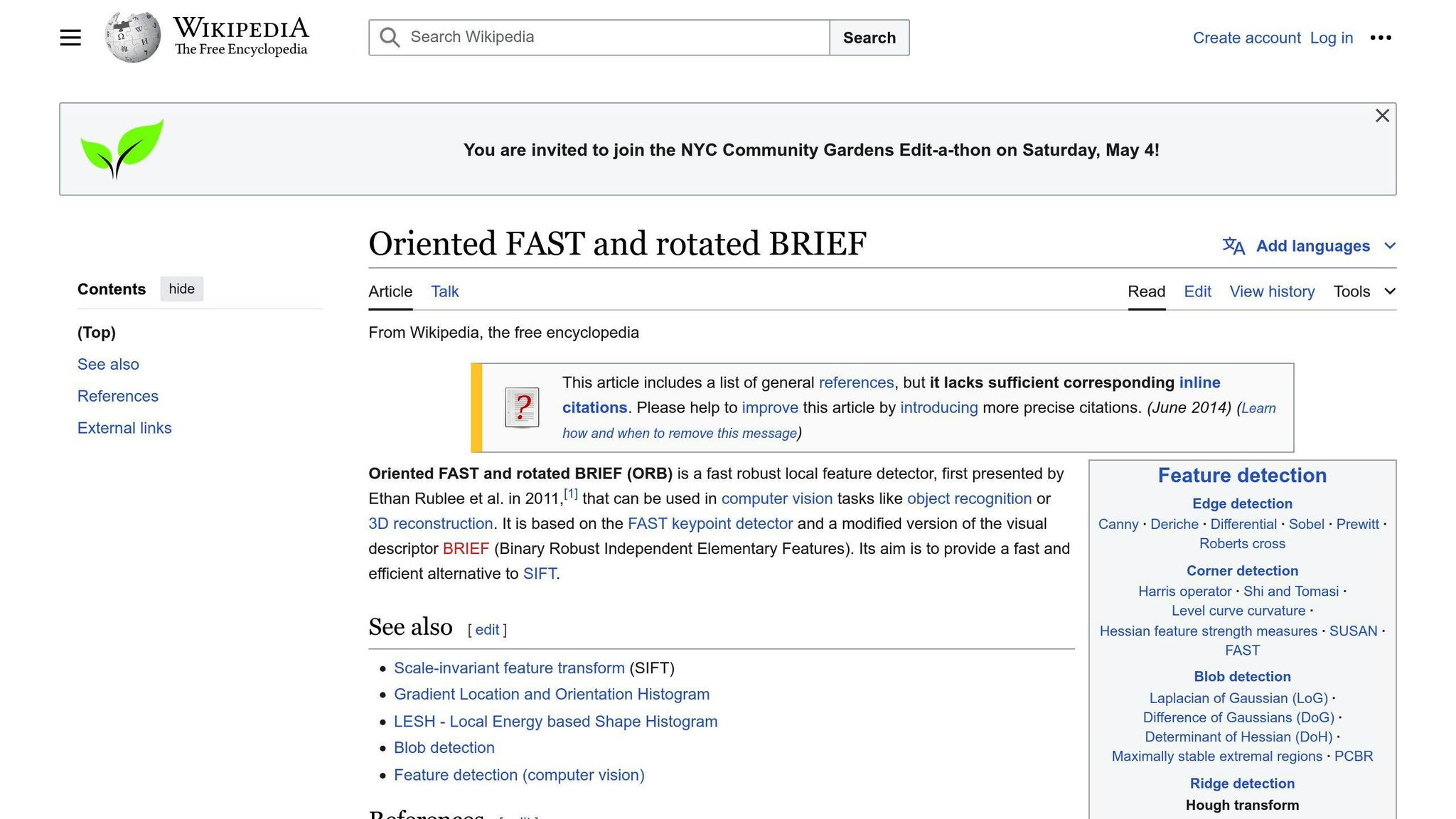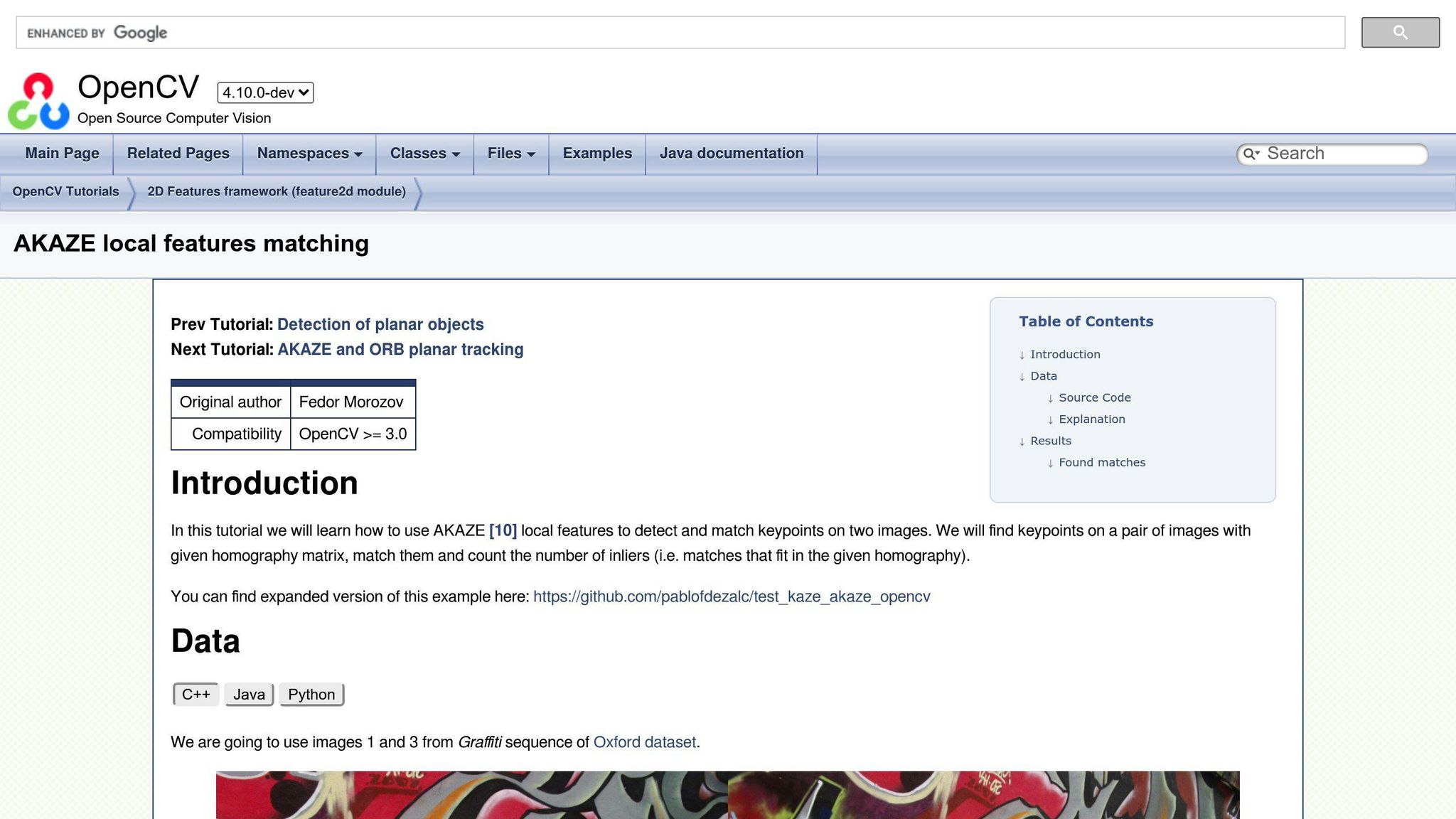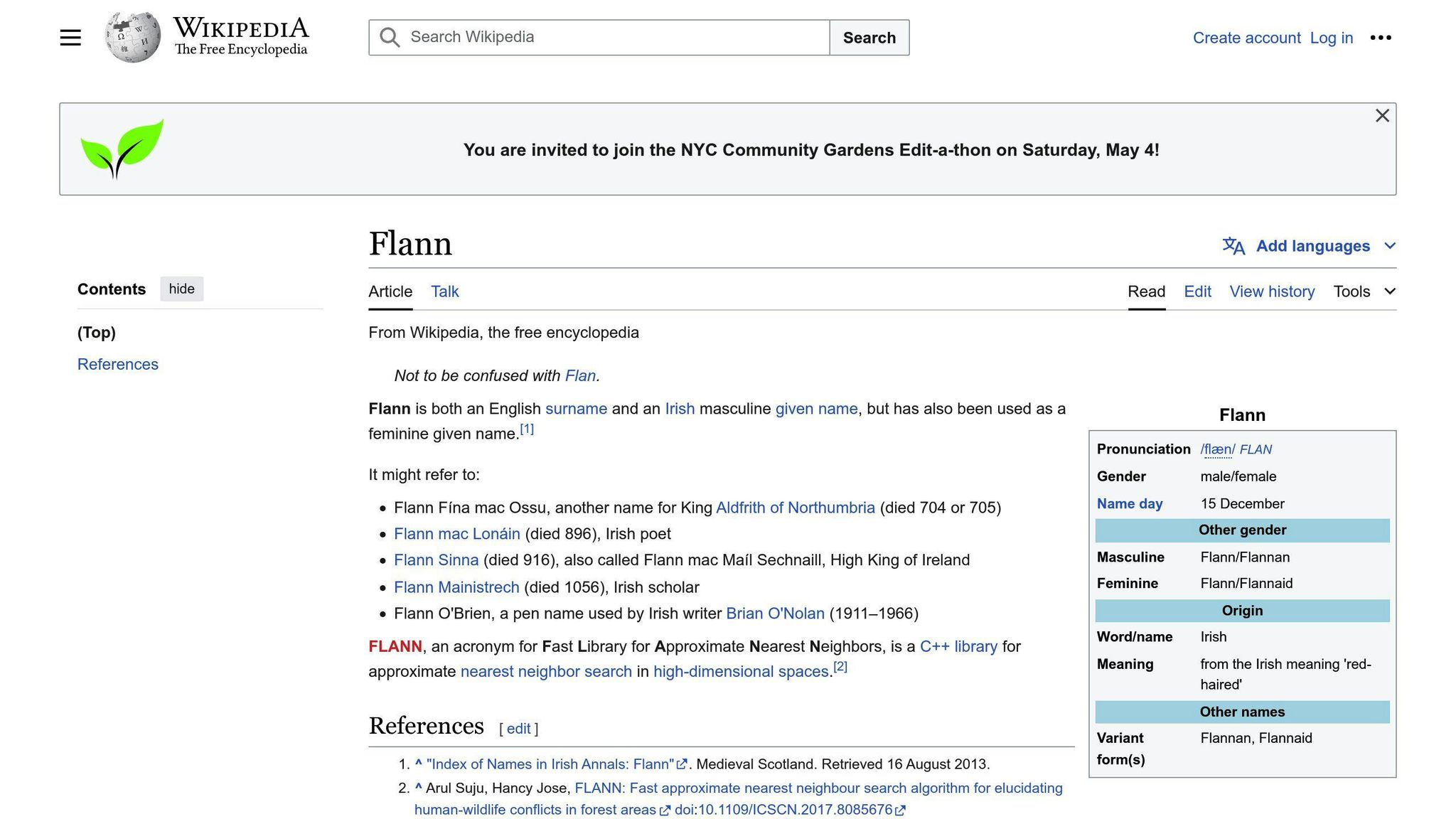Image matching algorithms help protect visual content on social media platforms by detecting duplicates, modified, or tampered images. These algorithms use various strategies to balance speed and accuracy, including:
| Strategy | Description |
|---|---|
| Hash-Based | Fast and suitable for exact duplicates and rescaled images |
| Perceptual Hashing | Fast and suitable for exact duplicates and rescaled images |
| Feature-Based (SIFT, ORB, AKAZE) | More robust and suitable for modified images |
Quick Comparison of Key Algorithms
| Algorithm | Speed | Accuracy | Robustness | Scalability |
|---|---|---|---|---|
| Hash-Based | Fast | High | Limited | Good |
| SIFT-Based | Slow | High | Good | Poor |
| ORB-Based | Fast | High | Good | Good |
| AKAZE-Based | Medium | High | Good | Good |
| Hybrid | Medium | High | Good | Good |
To protect social media visuals, consider factors like speed, accuracy, robustness, and scalability when selecting an image matching algorithm. Hash-based and ORB-based algorithms offer fast and accurate matching, while SIFT-based and hybrid algorithms provide robustness and scalability.
1. Hash-Based Image Matching
Hash-based image matching is a technique used to identify identical or similar images by assigning a unique digital identity, known as a hash value, to each image. This approach is useful for detecting duplicates, modified, or tampered images on social media platforms.
How it Works
Hash-based image matching is robust to transformations such as resizing, rotation, and slight color changes. This is because the hash value is generated based on the image’s visual features, rather than its raw pixel data.
Advantages
| Advantage | Description |
|---|---|
| Robustness to Transformations | Hash-based image matching can detect identical images even after resizing, rotation, or slight color changes. |
| Computational Efficiency | The process of generating hash values is fast, and the comparison of hash values is even faster. |
| Performance under Various Conditions | Hash-based image matching performs well under different lighting conditions, image formats, and compression levels. |
Hash-based image matching is a powerful technique for protecting visual content on social media platforms. Its advantages make it an effective solution for detecting duplicates, modified, or tampered images.
2. SIFT-Based Image Matching

SIFT (Scale-Invariant Feature Transform) is a widely used image matching algorithm that extracts and matches features between images.
How it Works
SIFT uses a scale-space approach to extract features, making it invariant to changes in image scale and orientation. This allows it to detect identical images even after transformations such as rotation, scaling, and affine transformations.
Advantages
| Advantage | Description |
|---|---|
| Robustness to Transformations | SIFT is invariant to image transformations such as rotation, scaling, and affine transformations. |
| Computational Efficiency | SIFT is computationally efficient, making it suitable for real-time image matching applications. |
| Performance under Various Conditions | SIFT performs well under changes in lighting, viewpoint, and occlusion. |
SIFT-based image matching is a powerful technique for protecting visual content on social media platforms. Its advantages make it an effective solution for detecting duplicates, modified, or tampered images.
3. ORB-Based Image Matching

ORB (Oriented FAST and Rotated BRIEF) is a fast and efficient image matching algorithm. It was developed at OpenCV labs in 2011 as an alternative to SIFT and SURF.
How it Works
ORB builds on the FAST keypoint detector and the BRIEF descriptor. This makes it a good choice for real-time image matching applications.
Advantages
| Advantage | Description |
|---|---|
| Fast Processing | ORB is almost two orders of magnitude faster than SIFT. |
| Good Performance | ORB performs as well as SIFT on feature detection and better than SURF. |
| Free to Use | ORB is free to use, unlike SIFT and SURF, which are patented algorithms. |
ORB-based image matching is a powerful technique for protecting visual content on social media platforms. Its advantages make it an effective solution for detecting duplicates, modified, or tampered images.
4. AKAZE-Based Image Matching

AKAZE-based image matching is a robust algorithm that can detect identical or similar images even after various transformations, such as rotations, scaling, and affine transformations.
How it Works
AKAZE detects and describes local features in an image, making it a reliable choice for image matching applications. This approach allows it to perform well under different conditions, including varying lighting, noise, and blur.
Advantages
| Advantage | Description |
|---|---|
| Robust to Transformations | AKAZE can detect identical images even after rotations, scaling, and affine transformations. |
| Good Performance | AKAZE performs well under different conditions, including varying lighting, noise, and blur. |
| Free to Use | AKAZE is an open-source algorithm, making it free to use and distribute. |
AKAZE-based image matching is an effective solution for detecting duplicates, modified, or tampered images on social media platforms. Its robustness to transformations, good performance under various conditions, and open-source nature make it a reliable and cost-efficient choice for protecting visual content.
5. FLANN-Based Image Matching

FLANN-based image matching is a robust algorithm that uses a set of techniques to achieve fast nearest neighbor search. This algorithm is particularly useful for protecting visual content on social media platforms.
How it Works
FLANN works by building an index of the data set using one of the supported indexing methods. Once the index is built, the user can perform nearest-neighbor searches by querying the index with a new point. The index returns the nearest neighbors to the query point, along with their distances.
Computational Efficiency
FLANN-based image matching is computationally efficient, making it suitable for large-scale image matching applications. It uses techniques like approximate k-d trees and randomized kd-trees to organize the data, allowing for faster search.
Performance under Various Conditions
FLANN-based image matching performs well under various conditions, including varying lighting, noise, and blur.
Licensing and Cost
FLANN is an open-source algorithm, making it free to use and distribute.
Here is an example of how to use FLANN and SIFT together in OpenCV for object detection:
import cv2
# Load the main and sub images
main_image = cv2.imread('main_image.jpg')
sub_image = cv2.imread('sub_image.jpg')
# Detect key points and compute descriptors using SIFT
sift = cv2.SIFT_create()
kp1, des1 = sift.detectAndCompute(main_image, None)
kp2, des2 = sift.detectAndCompute(sub_image, None)
# Create a FLANN object
flann = cv2.FlannBasedMatcher()
# Perform a k-nearest neighbor search
matches = flann.knnMatch(des1, des2, k=2)
# Filter matches using a distance ratio test
good_matches = []
for m, n in matches:
if m.distance < 0.7 * n.distance:
good_matches.append(m)
# Draw the good matches
img_matches = cv2.drawMatches(main_image, kp1, sub_image, kp2, good_matches, None)
cv2.imshow('Good Matches', img_matches)
cv2.waitKey()
This example demonstrates how to use FLANN-based image matching to detect identical or similar images on social media platforms. Its efficiency, performance, and open-source nature make it a reliable choice for protecting visual content.
6. HNSW-Based Image Matching

HNSW-based image matching is a robust algorithm that can detect identical or similar images even after various transformations, such as rotations, scaling, and affine transformations.
How it Works
HNSW-based image matching constructs a hierarchical graph structure, allowing it to efficiently search for nearest neighbors in high-dimensional spaces. This approach makes it robust to transformations and suitable for large-scale image matching applications.
Advantages
| Advantage | Description |
|---|---|
| Robust to Transformations | HNSW-based image matching can detect identical images even after rotations, scaling, and affine transformations. |
| Computational Efficiency | HNSW-based image matching is computationally efficient, making it suitable for large-scale image matching applications. |
| Scalability | HNSW-based image matching is highly scalable, making it suitable for large datasets. |
| Performance under Various Conditions | HNSW-based image matching performs well under various conditions, including varying lighting, noise, and blur. |
Example Usage
Here is an example of how to use HNSW-based image matching in OpenCV:
import cv2
# Load the main and sub images
main_image = cv2.imread('main_image.jpg')
sub_image = cv2.imread('sub_image.jpg')
# Detect key points and compute descriptors using SIFT
sift = cv2.SIFT_create()
kp1, des1 = sift.detectAndCompute(main_image, None)
kp2, des2 = sift.detectAndCompute(sub_image, None)
# Create an HNSW index
index = cv2.HNSWIndex(des1, 16)
# Perform a k-nearest neighbor search
distances, indices = index.knnSearch(des2, k=2)
# Filter matches using a distance ratio test
good_matches = []
for m, n in zip(distances, indices):
if m < 0.7 * n:
good_matches.append(m)
# Draw the good matches
img_matches = cv2.drawMatches(main_image, kp1, sub_image, kp2, good_matches, None)
cv2.imshow('Good Matches', img_matches)
cv2.waitKey()
This example demonstrates how to use HNSW-based image matching to detect identical or similar images on social media platforms. Its efficiency, scalability, and robustness make it a reliable choice for protecting visual content.
sbb-itb-738ac1e
7. Perceptual Hashing-Based Image Matching
Perceptual hashing-based image matching is a robust algorithm that can detect identical or similar images even after various transformations.
How it Works
Perceptual hashing algorithms generate a hash value based on the visual contents of an image. This approach makes them suitable for image matching applications.
Advantages
| Advantage | Description |
|---|---|
| Robust to Transformations | Perceptual hashing-based image matching can detect identical images even after rotations, scaling, and affine transformations. |
| Fast Processing | Perceptual hashing algorithms are computationally efficient, making them suitable for large-scale image matching applications. |
| Scalability | Perceptual hashing-based image matching is highly scalable, making it suitable for large datasets. |
Example Usage
Perceptual hashing-based image matching can be used in various applications, such as digital forensics and copyright infringement detection. For instance, in digital forensics, perceptual hashing can be used to identify similar images in a large dataset, helping investigators to track down the source of an image.
By using perceptual hashing-based image matching, social media platforms can effectively protect visual content from unauthorized use and ensure that users are not sharing copyrighted or harmful images.
8. Blockchain-Based Image Matching
How it Works
Blockchain-based image matching uses a decentralized approach to protect visual content on social media platforms. This technology combines blockchain’s immutability and transparency with image recognition algorithms to create a robust system for detecting copyright infringement. By storing image features on a blockchain, the system enables automatic detection of similar images and tamper-proof traceability.
Advantages
| Advantage | Description |
|---|---|
| Decentralized Storage | Image features are stored in a decentralized manner, making it difficult for hackers to manipulate or alter the data. |
| Tamper-Proof | The use of blockchain technology ensures that image features are stored in an immutable ledger, preventing any unauthorized changes or tampering. |
| Automatic Detection | This system enables automatic detection of similar images, making it easier to identify copyright infringement and take necessary actions. |
Example Usage
Blockchain-based image matching can be used in various applications, such as digital forensics and copyright infringement detection. For instance, social media platforms can use this technology to identify similar images in a large dataset, helping to track down the source of an image and prevent unauthorized use.
By leveraging blockchain-based image matching, social media platforms can effectively protect visual content from unauthorized use and ensure that users are not sharing copyrighted or harmful images.
9. Digital Watermarking-Based Image Matching
How it Works
Digital watermarking-based image matching involves embedding a watermark, either textual or semi-transparent, onto the image itself. This watermark can be a logo, signature, or website address, making it difficult for thieves to remove. The watermark serves as a digital signature, allowing the owner to identify their images and track unauthorized use.
Advantages
| Advantage | Description |
|---|---|
| Deterrent Effect | Watermarks discourage thieves from copying images, as they are more likely to be caught and traced back to the original owner. |
| Difficult to Remove | Watermarks are challenging to remove, especially semi-transparent ones, making it harder for thieves to alter the image. |
| Brand Visibility | Watermarks provide visibility to the owner’s brand or name, making it clear that the image belongs to them. |
Example Usage
Digital watermarking-based image matching can be used in various applications, such as digital forensics and copyright infringement detection. For instance, social media platforms can use this technology to identify similar images in a large dataset, helping to track down the source of an image and prevent unauthorized use. By leveraging digital watermarking-based image matching, social media platforms can effectively protect visual content from unauthorized use and ensure that users are not sharing copyrighted or harmful images.
10. Hybrid Image Matching
Hybrid image matching algorithms combine multiple techniques to achieve robustness against various transformations, such as scaling, rotation, mirroring, and cropping.
Robustness to Transformations
Hybrid approaches leverage the strengths of different algorithms to identify similar images even when they have undergone significant transformations.
Computational Efficiency
Hybrid image matching algorithms balance computational efficiency with accuracy. By using a multi-pass approach, they reduce the computational overhead associated with image matching.
Performance under Various Conditions
Hybrid algorithms perform well under various conditions, including changes in lighting, camera angles, and image quality.
Scalability
Hybrid image matching algorithms are scalable, making them ideal for large-scale applications, such as social media platforms.
Ease of Integration
Hybrid algorithms can be easily integrated into existing systems, making them a practical solution for social media platforms and other applications.
| Advantage | Description |
|---|---|
| Robustness | Hybrid approaches identify similar images even after transformations. |
| Efficiency | Hybrid algorithms balance efficiency with accuracy. |
| Performance | Hybrid algorithms perform well under various conditions. |
| Scalability | Hybrid algorithms are suitable for large-scale applications. |
| Ease of Integration | Hybrid algorithms can be easily integrated into existing systems. |
Pros and Cons Comparison
In this section, we will compare the advantages and disadvantages of each image matching algorithm discussed in this article. This comparison will help you understand the strengths and weaknesses of each algorithm and make an informed decision about which one to use for your specific use case.
Hash-Based Image Matching
| Advantage | Description |
|---|---|
| Fast computation | Hash-based image matching is fast and can handle large datasets. |
| Simple implementation | The algorithm is easy to implement and requires minimal resources. |
| Good for exact duplicates | Hash-based image matching is effective for finding exact duplicates of an image. |
| Disadvantage | Description |
|---|---|
| Limited robustness | Hash-based image matching is sensitive to image transformations and may not perform well with rotated, scaled, or cropped images. |
| Not suitable for modified images | The algorithm is not effective for finding modified versions of an image. |
SIFT-Based Image Matching
| Advantage | Description |
|---|---|
| Robust to transformations | SIFT-based image matching is robust to image transformations such as rotation, scaling, and cropping. |
| Good for modified images | The algorithm can find modified versions of an image, including those with changes in lighting, camera angles, and image quality. |
| High accuracy | SIFT-based image matching has high accuracy and can detect subtle differences between images. |
| Disadvantage | Description |
|---|---|
| Computationally expensive | SIFT-based image matching is computationally expensive and may require significant resources. |
| Slow performance | The algorithm can be slow, especially for large datasets. |
Perceptual Hashing-Based Image Matching
| Advantage | Description |
|---|---|
| Fast computation | Perceptual hashing-based image matching is fast and can handle large datasets. |
| Good for rescaled images | The algorithm is effective for finding rescaled versions of an image. |
| High accuracy | Perceptual hashing-based image matching has high accuracy and can detect subtle differences between images. |
| Disadvantage | Description |
|---|---|
| Limited robustness | Perceptual hashing-based image matching is sensitive to image transformations and may not perform well with rotated, scaled, or cropped images. |
| Not suitable for modified images | The algorithm is not effective for finding modified versions of an image. |
Hybrid Image Matching
| Advantage | Description |
|---|---|
| Robust to transformations | Hybrid image matching is robust to image transformations such as rotation, scaling, and cropping. |
| Good for modified images | The algorithm can find modified versions of an image, including those with changes in lighting, camera angles, and image quality. |
| High accuracy | Hybrid image matching has high accuracy and can detect subtle differences between images. |
| Scalable | The algorithm is scalable and can handle large datasets. |
| Easy integration | Hybrid image matching can be easily integrated into existing systems. |
| Disadvantage | Description |
|---|---|
| Computationally expensive | Hybrid image matching is computationally expensive and may require significant resources. |
| Complex implementation | The algorithm is complex and may require expertise to implement. |
By comparing the advantages and disadvantages of each image matching algorithm, you can choose the best algorithm for your specific use case. Remember to consider factors such as computational efficiency, robustness to transformations, and accuracy when making your decision.
Evaluating the Algorithms
When choosing an image matching algorithm, it’s crucial to consider various factors that affect their performance. In this section, we’ll analyze each algorithm’s strengths and weaknesses to help you decide which one is best for protecting social media visuals.
Key Performance Indicators (KPIs)
To evaluate the algorithms, we’ll focus on the following KPIs:
| KPI | Description |
|---|---|
| Speed | The time taken to match images, critical for real-time applications. |
| Accuracy | The ability to correctly identify matching images, even with variations. |
| Robustness | The algorithm’s ability to handle noisy or distorted images. |
| Scalability | The algorithm’s ability to handle large datasets and high-volume image matching. |
Algorithm Evaluation
Using the KPIs above, let’s evaluate each algorithm:
| Algorithm | Speed | Accuracy | Robustness | Scalability |
|---|---|---|---|---|
| Hash-Based | Fast | High | Limited | Good |
| SIFT-Based | Slow | High | Good | Poor |
| ORB-Based | Fast | High | Good | Good |
| AKAZE-Based | Medium | High | Good | Good |
| Hybrid | Medium | High | Good | Good |
Algorithm Selection
Based on the evaluation, you can select the most suitable algorithm for your specific use case:
- For fast and accurate matching, consider Hash-Based or ORB-Based algorithms.
- For robustness and scalability, consider SIFT-Based or Hybrid algorithms.
- For a balance between speed and accuracy, consider AKAZE-Based algorithms.
By understanding the strengths and weaknesses of each algorithm, you can make an informed decision about which one to use for protecting your social media visuals.
Key Takeaways
In conclusion, choosing the right image matching algorithm is crucial for protecting social media visuals. Each algorithm has its strengths and weaknesses, and understanding these trade-offs is essential.
Algorithm Selection Criteria
When selecting an algorithm, consider the following factors:
| Factor | Description |
|---|---|
| Speed | The time taken to match images, critical for real-time applications. |
| Accuracy | The ability to correctly identify matching images, even with variations. |
| Robustness | The algorithm’s ability to handle noisy or distorted images. |
| Scalability | The algorithm’s ability to handle large datasets and high-volume image matching. |
Algorithm Comparison
Here’s a brief comparison of the algorithms discussed:
| Algorithm | Speed | Accuracy | Robustness | Scalability |
|---|---|---|---|---|
| Hash-Based | Fast | High | Limited | Good |
| SIFT-Based | Slow | High | Good | Poor |
| ORB-Based | Fast | High | Good | Good |
| AKAZE-Based | Medium | High | Good | Good |
| Hybrid | Medium | High | Good | Good |
By considering these factors and evaluating the algorithms, you can make an informed decision about which one to use for protecting your social media visuals.

